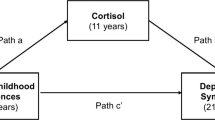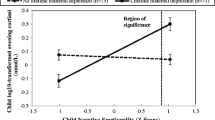Abstract
Individual differences in the level of the stress hormone cortisol play a prominent role as an explanatory variable in studies on psychopathology. Relatively few studies have paid attention to individual differences in cortisol levels and the etiology of these differences, in particular their possible genetic basis. All these studies have been in adults. The aim of this study was to estimate genetic and environmental influences on basal cortisol levels in 12-year-old children. To this end, four samples of salivary cortisol were collected on two consecutive days in a sample of 180 twin pairs. Low correlations were found between cortisol levels at different points in time during the day. A significant genetic contribution was found to the variation of basal cortisol levels in the morning and afternoon samples, but not in the evening sample. Heritability did not differ for boys and girls and was highest (60%) for cortisol levels during the sample taken about 45 minutes after awakening. This cortisol awakening response provides a useful endophenotype in the search for genes that may affect hypothalamic-pituitary adrenocortical functioning in children.
Similar content being viewed by others
References
Aardal, E., and Holm, A. C. (1995). Cortisol in saliva—reference ranges and relation to cortisol in serum. Eur. J. Clin. Chem. Clin. Biochem. 33(12):927-932.
Bartels, M., Van den Berg, M., Sluyter, F., Boomsma, D. I., and De Geus, E. J. C. (2003). Heritability of cortisol; Review and simultaneous analysis of twin studies. Psychoneuroendocrinology 28:121-137.
Bartels, M., Rietveld, M. J. H., Van Baal, G. C. M., Boomsma, D. I. (2002a). Genetic and environmental influences on the development of intelligence. Behavior Genetics 32(4):237-249.
Bartels, M., Van den Oord, E. J. C. G., Hudziak, J. J., Rietveld, M. J. H., van Beijsterveldt, C. E. M., and Boomsma, D. I. (2002b). Genetic and environmental mechanisms underlying stability and change in problem behaviors at ages 3, 7, 10, and 12. Developmental Psychology (under revision).
Blizzard, D. A. (1992). Analyzing phenotypic correlations in studies with selected lines. Behav. Genet. 22(1):29-33.
Boomsma, D. I. (1998). Twin registers in Europe: An overview. Twin Res. 1:34-51.
Dallman, M. F., Akana, S. F., Cascio, S. F., Darlington, D. N., Jacobson, L., and Levin, N. (1987). Regulation of ACTH secretion: Variation on a theme of B. Recent. Progr. Horm. Res. 43:133-173.
Dawes, M. A., Dorn, L. D., Moss, H. B., Yao, J. K., Kirisci, L., Ammerman, R. T., and Tarter, R. E. (1999). Hormonal and behavioral homeostasis in boys at risk for substance abuse. Drug Alcohol Depend. 55:165-176.
DeKloet, E. R. (1991). Brain corticosteroid receptor balance and homeostatic control. Front Neuroendocrinology 12:95-164.
DeKloet, E. R. (2000). Stress in the brain. European Journal of Pharmacology 405:187-198.
Dorn, L. D., Hitt, S. F., and Rotenstein, D. (1999). Biopsychological and cognitive differences in children with premature vs. on-time adrenarche. Arch. Pediatr. Adolesc. Med. 153(2):137-146.
Dressendörfer, R. A., Kirschbaum, C., Rohde, C., Stahl, F., and Strasburger, C. J. (1992). Synthesis of a cortisol-biotin conjugate and evaluation as a tracer in an immunoassay for salivary cortisol measurement. J. Steroid. Biochem. Mol. Biol. 43:683-692.
Edelbrock, C., Rende, R., Plomin, R., and Thompson, L. (1995). A twin study of competence and problem behavior in childhood and adolescence. J. Child. Psychol. Psychiatry 31(2):775-785.
Froehlich, J. C., Zink, R. W., Li, T. K., and Christian, J. C. (2000). Analysis of heritability of hormonal responses to alcohol in twins: Beta-endorphin as a potential biomarker of genetic risk for alcoholism. Alcohol. Clin. Exp. Res. 24:265-277.
Gantz, I., Tashiro, T., Barcroft, C., Konda, Y., Shimoto, Y., Miwa, H., Glover, T., Munzert, G., and Yamada, T. (1993). Localization of the genes encoding the melanocortin-2 (adrenocorticotropic hormone) and melanocortin-3 receptors to chromosomes 18p11.2 and 20q13.2-q13.3 by fluorescence in situ hybridization. Genomics 18:166-167.
Granger, D. A., Weisz, J. R., and Kauneckis, D. (1994). Neuroendocrine reactivity, internalizing behavior problems, and control-related cognition in clinic-referred children and adolescents. J. Abnorm. Psychol. 103(2):267-276.
Huizenga, N. A., Koper, J. W., De Lange, P., Pols, H. A., Stolk, R. P., Burger, H., Grobbee, D. E., Brinkmann, A. O., De Jont, F. H., and Lamberts, S. W. (1998). A polymorphism in the glucocorticoid receptor gene may be associated with and increased sensitivity to glucocorticoids in vivo. J. Clin. Endocrinol. Metah. 83:144-151.
Inglis, G. C., Ingram, M. C., Holloway, C. D., Swan, L., Birnie, D., Hillis, W. S., Davies, E., Fraser, R., and Connell, J. M. (1999). Familial pattern of corticosteroids and their metabolism in adult human subjects—The Scottish Adult Twin Study. J. Clin. Endocrinol. Metab. 84(11):4132-4137.
Jacobson, L., and Sapolsky, R. (1991). The role of the hippocampus in feedback regulation of the hypothalamic-pituitary-adrenocortical axis. Endocr. Rev. 12:118-134.
Kagan, J., Reznick, J. S., and Snidman, N. (1987). The physiology and psychology of behavioral inhibition in children. Child Dev. 58:1459-1473.
Kirschbaum, C., and Hellhammer, D. H. (1994). Salivary cortisol in psychoneuroendocrine research: Recent developments and applications. Psychoneuroendocrinology 19(4):313-333.
Kirschbaum, C., Wüst, S., Faig, H. G., and Hellhammer, D. H. (1992). Heritability of cortisol responses to human corticotropinreleasing hormone, ergometry, and psychological stress in humans. J. Clin. Endocrin. Metab. 75(6):1526-1530.
Koot, H. M. (1995). Longitudinal studies of general population and community samples. In F. C. Verhulst and H. M. Koot (eds.), The epidemiology of child and adolescent psychopathology. London: Oxford University Press.
Linkowski, P., Van Onderbergen, A., Kerkhofs, M., Bosson, D., Mendlewicz, J., and Van Cauter, E., (1993). Twin study of the 24-h cortisol profile: Evidence for genetic control of the human circadian clock. A. J. Physiology 264(2 Pt 1):E173-81.
Marshall, W. A., and Tanner, J. M. (1969). Variations in pattern of pubertal changes in girls. Archives of Disease in Childhood 44:291-303.
Marshall, W. A., and Tanner, J. M. (1970). Variations in pattern of pubertal changes in boys. Archives of Disease in Childhood 45:13-23.
Maxwell, J. D., Boyle, J. A., Greig, W. R., and Buchanan, W. W. (1969). Plasma corticosteroids in healthy twin pairs. J. Med. Genet. 6:294-297.
McBurnett, K., Lahey, B. B., Capasso, L., and Loeber, R. (1996). Aggressive symptoms and salivary cortisol in clinic-referred boys with conduct disorder. An. N.Y. Acad. Sc. 794:169-178.
McBurnett, K., Lahey, B. B., Rathouz, P. J., and Loeber, R. (2000). Low salivary cortisol and persistent aggression in boys referred for disruptive behavior. Arch. Gen. Psychiatry 57(1):38-43.
Meijer, O. C., de Kloet, E. R., and McEwen, B. S. (2000). Corticosteroid receptors. In G. Fink (ed.), Encyclopedia of stress. Academic Press, London.
Meikle, A. W., Stringham, J. D., Woodward, M. G., and Bishop, D. T. (1988). Heritability of variation of plasma cortisol levels. Metabolism 37(6):514-517.
Moss, H. B., Vanyukov, M. M., and Martin, C. S. (1995). Salivary cortisol responses and the risk for substance abuse in prepubertal boys. Biol. Psychiatry 38(8):547-555.
Mountjoy, K. G., Robbins, L. S., Mortrud, M. T., and Cone, R. D. (1992). Science 257:48-51.
Neale, M. C., Boker, S. M., Xie, G., and Maes, H. H. (1999). Mx: Statistical modeling (5th ed.), Richmond, VA: Medical College of Virginia, Department of Psychiatry.
Nurnberger, J. I., Gershon, E. S., Simmons, S., Ebert, M., Kessler, L. R., Dibble, E. D., Jimerson, S. S., Brown, G. M., Gold, P., Jimerson, D. C., Guroff, J. J., and Storch, F. I. (1982). Behavioral, biochemical and neuroendocrine responses to amphetamine in normal twins and “well-state” bipolar patients. Psychoneuroendocrinology 7:163-176.
Plomin, R., DeFries, J. C., McClearn, G. E., and Rutter, M. (1997). Behavioral genetics: A primer New York: Freeman.
Posthuma, D., and Boomsma, D. I. (2000). A note on the statistical power in extended twin designs. Behav. Genet. 30(2):147-158.
Pritchard, J., Despres, J. P., Gagnon, J., Tchernof, A., Nadeau, A., Tremblay, A., and Bouchard, C. (1998). Plasma adrenal, gonadal, and conjugated steroids before and after long-term overfeeding in identical twins. J. Clin. Endocrinol. Metab. 83:3277-3284.
Pritchard, J., Despres, J. P., Gagnon, J., Tchernof, A., Nadeau, A., Tremblay, A., and Bouchard, C. (1999). Plasma adrenal, gonadal, and conjugated steroids following long-term exercise-induced negative energy balance in identical twins. Metabolism 48:1120-1127.
Reul, J. M. H. M., and De Kloet, E. R. (1985). Two receptor systems for corticosterone in the rat brain: Microdistribution and differential occupation. Endocrinology 117:2505-2511.
Riad-Fahmy, D., Read, G. F., Walker, R. F., and Griffiths, K. (1982). Steroids in saliva for assessing endocrine function. Endoc. Rev. 3(4):367-395.
Rietveld, M. J. H., van Baal, G. C. M., Dolan, C. V., and Boomsma, D. I. (2000). Genetic factor analyses of specific cognitive abilities in 5-year-old Dutch children. Behav. Gen. 30(1):29-40.
Rosmond, R., Chagnon, Y. C., Chagnon, M., Perusse, L., Bouchard, C., and Bjorntorp, P. (2000a). Apolymorphism of the 5′-flanking region of the glucocorticoid receptor gene locus is associated with basal cortisol secretion in men. Metabolism 49:1197-1199.
Rosmond, R., Chagnon, Y. C., Holm, G., Chagnon, M., Perusse, L., Lindell, K., Carlsson, B., Bouchard, C., and Bjorntorp, P. (2000b). A glucocorticoid receptor gene marker is associated with abdominal obesity, leptin, and dysregulation of the hypothalamic-pituitary-adrenal axis. Obes. 8:211-218.
Ruiz, M., Lind, U., Gåfvels, M., Eggertsen, G., Carlstedt-Duke, J., Nilsson, L., Holtman, M., Stierna, P., Wikström, A., and Werner, S. (2001). Characterization of two novel mutations in the glucocorticoid receptor gene in patients with primary cortisol resitance. Clinical Endocrinology 55(3):363-371.
Scerbo, A. S., and Kolko, D. J. (1994). Salivary testosterone and cortisol in disruptive children: Relationship to aggressive, hyperactive, and internalizing behaviors. J. Am. Acad. Child Adolesc. Psychiatry 33(8):1174-1184.
Schmitz, S., Cherny, S. S., and Fulker, D. W. (1998). Increase in power through multivariate analyses. Behav. Genet. 28(5):357-363.
Schmitz, S., Fulker, D. W., and Mrazek, D. A. (1995). Problem behavior in early and middle childhood: An initial behavior genetic analysis. J. Child Psychol. Psychiatry 36(8): 1443-1458.
Tennes, K., and Kreye, M. (1985). Children's adrenocortical responses to classroom activities and tests in elementary school. Psychosom. Med. 47:451-460.
Tennes, K., Kreye, M., Avitable, N., and Wells, R. (1986). Behavioral correlates of excreted catecholamines and cortisol in second grade children. J. Am. Acad. Child Psychiatry 25:764-770.
Vamvakpoulos, N. C., and Chrousos, G. P. (1994). Hormonal regulation of human corticotropin-releasing hormone gene expression: Implications for the stress response and immune/inflammatory reaction. Endr. Rev. 15:409-420.
Vanyukov, M. M., Moss, H. B., Plail, J. A., Blackson, T., Mezzich, A. C., and Tarter, R. E. (1993). Antisocial symptoms in preadolescent boys and their parents: Associations with cortisol. Psychiatry Res. 46:9-17.
Van den Oord, E. J. C. G., Boomsma, D. I., and Verhulst, F. C. (1994). A study of problem behaviors in 10-to 15-year-old biologically related and unrelated international adoptees. Behav. Genet. 24(3):349-357.
Van der Valk, J. C., Verhulst, F. C., Stroet, T. M., and Boomsma, D. I. (1998a). Quantitative genetic analysis of Internalizing and Externalizing problems in a large sample of 3-year-old twins. Twin Research 1(1):25-33.
Van der Valk, J. C., Verhulst, F. C., Neale, M. C., and Boomsma, D. I. (1998b). Longitudinal genetic analysis of problem behaviors in biologically related and unrelated adoptees. Behav. Genet. 28(5):365-380.
Van Goozen, S. H. M., Matthys, W., Cohen-Kettenis, P. T., Gispende Wied, C., Wiegant, V. M., and Engeland, H. (1998). Salivary cortisol and cardiovascular activity during stress in oppositional defiant disorder boys and normal controls. Biol. Psychiatry 43:531-539.
Verhulst, F. C., and van der Ende, J. (1993). “Comorbidity” in an epidemiological sample: A longitudinal perspective. J. Child Psychol. Psychiatry 34(5):767-783.
Weitzman, E. D., Fukushima, D., Nogeire, C., Roffwarg, H., Gallagher, T. F., and Hellman, L. (1971). Twenty-four hour pattern of the episodic secretion of cortisol in normal subjects. J. Clin. Endocrinol. Metab. 33:14-22.
Wüst, S., Federenko, I., Hellhammer, D. H., and Kirchbaum, C. (2000). Genetic factors, perceived chronic stress, and the free cortisol response to awakening. Psychoneuroendocrinology 25:707-720.
Young, E. A., Aggen, S. H., Prescott, G. A., and Kendler, K. S. (2000). Similarity in saliva cortisol measures in monozygotic twins and the influence of past major depression. Biol. Psychiatry 48:70-74.
Rights and permissions
About this article
Cite this article
Bartels, M., de Geus, E.J.C., Kirschbaum, C. et al. Heritability of Daytime Cortisol Levels in Children. Behav Genet 33, 421–433 (2003). https://doi.org/10.1023/A:1025321609994
Issue Date:
DOI: https://doi.org/10.1023/A:1025321609994




